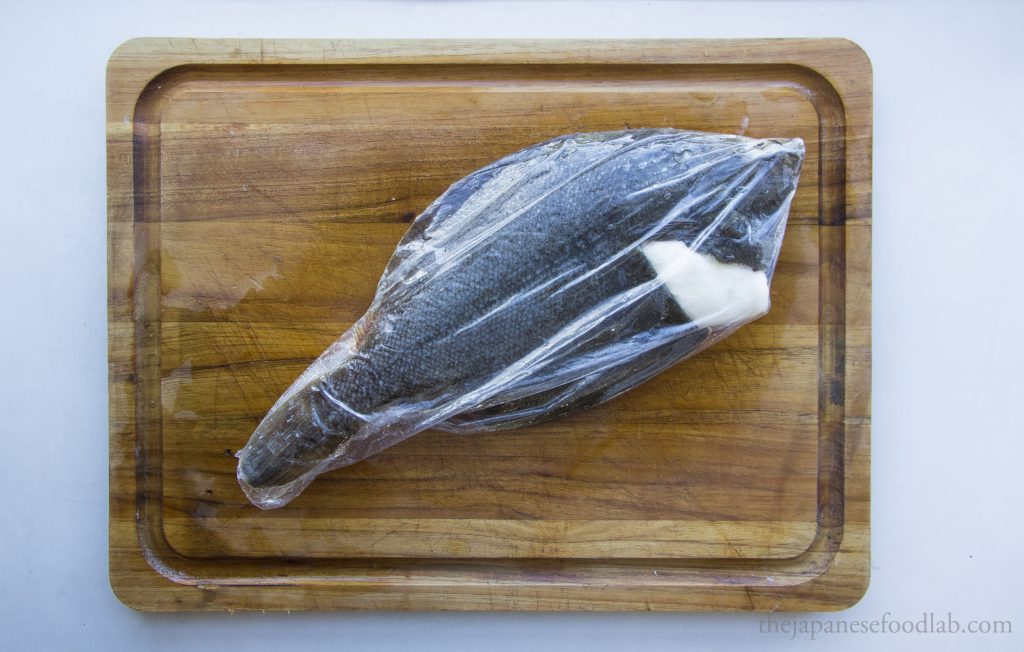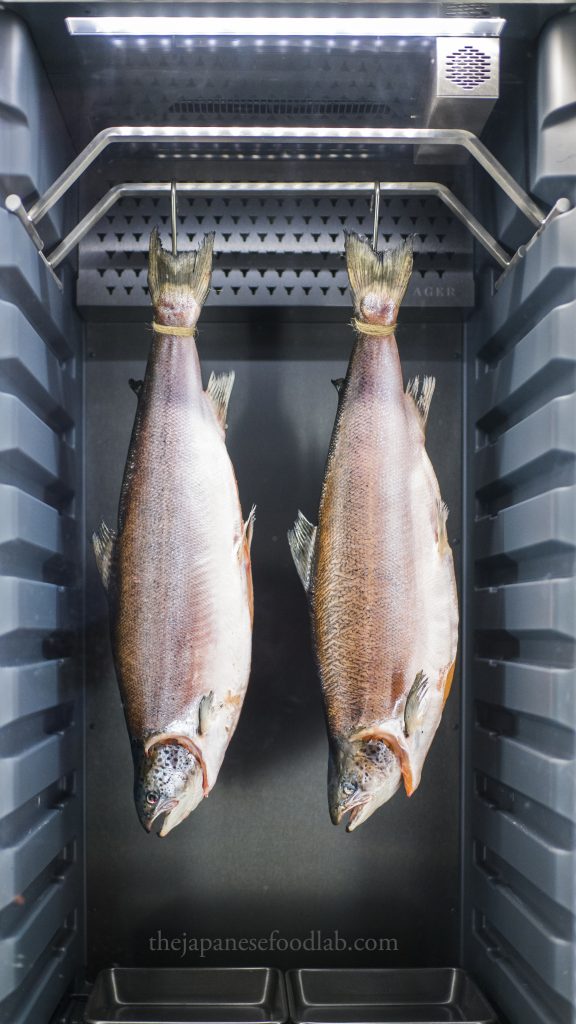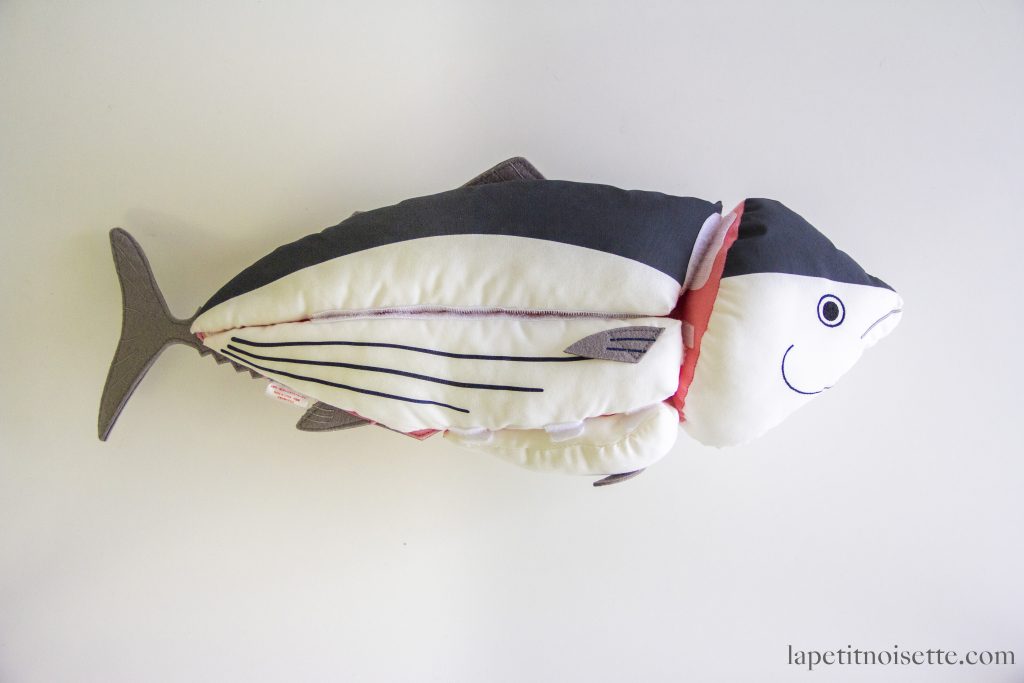As with all safety information on this website, the information here does not constitute professional advice. If you have any concern over safety, consult a professional or speak to your doctor for advice.
When aging fish, two competing biological processes are at work. On one hand, you have enzymes naturally present in the flesh of the fish breaking down proteins to improve flavor and texture. On the other hand, the fish also provides a moist and nutrient rich environment on which bacteria thrive. If not carefully controlled, the growth of bacteria occurs at a much faster rate than enzyme activity and the fish starts to go bad.

Water activity and aging fish
This is especially problematic for wet aged fish, which maintains the water activity in the flesh and surface of the fish. As water activity is the amount of ‘free’ water available to participate in the chemical reactions, both enzyme activity and bacteria growth occurs at a much higher rate. To circumvent this problem, we wet age fish at a temperature close to freezing point that greatly inhibits bacterial growth. As the rate of enzyme function is closely related to temperature, the rate of enzyme activity also decreases but at a lower rate compared to bacterial growth. Therefore, improvement of flavor and texture can still be achieved.
Dry aged fish and bacterial growth
In contrast, the dry aging environment is much more desiccating, and thus the exposed surfaces of the fish quickly dry out. This combined with near freezing point temperatures make it an extremely harsh environment for bacterial growth, thus allowing the improvement of flavor and texture due to enzymatic action to take place without the fear of the fish going bad.
This is why fish can only be wet aged for a couple of days compared to dry aging. The humid environment provided by wet aging allows for faster flavor development but at a higher rate of quality deterioration. Meanwhile dry aging fish is slower but more consistent.

Technological advances in fish aging safety
As aging fish requires fish to mature for periods of time much longer than people are accustomed to, there are many concerns surrounding the safety of aging fish. In response to these concerns, many technological advances have been developed in order to improve the safety and reliability of aging fish and meat.
Precise temperature and humidity control
There exists specialized fridges available commercially that are able to maintain the internal temperature of the fridge to an accuracy of half a degree. This is especially common for fridges in Japan that are designed to wet age fish.
Specialist dry aging fridges (or cabinets, which is the posh marketing word used), also have a high degree of precision when it comes to temperature control and may also have the addition of a cooling fan that quickly works to cool the environment back down to the target temperature after the door is opened, before quickly shutting off when the target temperature is reached.
This is much better for the fish compared to your conventional fridge with an automated cooling fan that quickly desiccates the fish beyond edibility if not stored in a sealed environment. This is just one of the reasons why it is difficult to age fish at home.
Specialist dry aging fridges also have the added bonus of being able to maintain a consistent humidity over long periods of time, a requirement for dry aging but not wet aging fish.
Ultraviolet sterilization and carbon filters
As dry aged fish are directly exposed to the refrigeration environment and left to mature for a much longer period of time, the safety concerns of dry aged fish are much greater compared to wet aged fish. Because of this, the very top end dry age refrigerators are equipped with self cleaning and air filtering functions.
For example, most specialist dry aged fridges are equipped with ultraviolet light that kills unwanted bacteria by damaging their DNA. These fridges make use of ultraviolet light on the shorter end of the wavelength spectrum known as UVC. It’s interesting to note that our sun actually naturally produces UVC but all of it is absorbed by the ozone layer and thus is unable to harm us. Because of this, the UVC bulb in a dry aged fridge is usually kept out of sight so that only air that passes through the light is sterilized.
Another common addition you’ll find are filters that purify the air of any unwanted particles or gasses, with the most common ones being carbon filters. It’s worth nothing that both carbon filters and UVC bulbs require changing every so often.
Because dry aging fish uses the same technology as dry aging beef and the dry aged beef industry has been around for much longer, the technology available is far more advanced than fridges used for wet aging. This is partly due to the fact that wet aging fish is far more forgiving and only requires you to have an environment that can control temperature up to ±1°C precision.

Scombroid food poisoning in aged fish
Scombroid food poisoning, also known as histamine fish poisoning (ヒスタミン魚中毒), is a safety concern that arises from eating fish that’s cold chain has been broken at any point. To understand scombroid food poisoning, let’s first look at some background biology.
There exists 20 (or 21 if you include selenium) amino acids that are the foundational building blocks for all proteins in life. Of the 20 amino acids, the ones that humans and fish are unable to synthesize and must obtain from the environment are known as essential amino acids. One of these amino acids is histidine and is the cause of scombroid food poisoning.
As the rate of chemical reactions increases with temperature, if fish are not stored at a low enough temperature, the histidine undergoes a decarboxylation reaction catalyzed by an enzyme called histidine decarboxylase and is converted into histamine and carbon dioxide.
Histidine → Histamine + Carbon Dioxide
Other than small amounts of histidine decarboxylase present in the cells of the fish, bacteria are mainly responsible for the production of histidine decarboxylase. Because the increase in temperature also increases the rate of bacteria growth, so too does the amount of histidine decarboxylase present to convert histidine to histamine.
The histamine starts to build up in the fish and upon consumption, enters the human body and causes an inflammation reaction that causes symptoms such as rashes, flushing, headaches and diarrhea.
It’s worth noting that histamine in itself is not poisonous to humans. It is released as part of our natural response to infections and is the chemical that causes swelling around cuts, allowing white blood cells and antibodies to quickly reach the site.
The problems occur when the body is exposed to too much histamine. If the symptoms of scombroid poisoning sound familiar to you, it’s because it’s the same symptoms as an allergic reaction. During an allergic reaction, our body overreacts to the allergen and releases a high level of histamine. Because of this, some people experiencing scombroid poisoning think that they’re having an allergic reaction.
During scombroid poisoning, the person has not actually been exposed to an allergen and has instead consumed a high amount of histamine directly. This is why the treatment for an allergic reaction like an epipen does not work for scombroid poisoning. Instead, antihistamine tablets like the ones used for hay fever usually suffice.
While cases of scombroid fish poisoning are rare as long as the fish is not temperature abused, they’re more likely to occur from fishes that are part of the Scombridae family which include mackerel, tuna and bonito. This is because fish from this family tend to have a higher natural level of histidine in their flesh, thus explaining where the term scombroid fish poisoning originates from.
While exposing the fish to high heat through cooking and smoking does kill off the bacteria, it is not enough to denature the histamine proteins and thus even cooked fish can cause scombroid poisoning.
Anisakis parasites
When it comes to eating fish, especially in raw preparations such as sushi, a conversation about safety is never completed with talking about anisakis parasites. We’ve covered this topic in great detail in our article on how to choose fish for sashimi which we highly recommend reading first.
As dry aging fish is a fairly new phenomenon, not much research or information is available on its effect on anisakis parasites. However, based on the information we have available on the anisakis life cycle, we can make a fairly accurate guess.
Unfortunately, because the temperature at which dry aging and wet aging occurs is above the freezing point, neither process has any effect on killing of anisakis parasites. If anything, anisakis worms would most likely simply go dormant at these low temperatures.
However, if you follow the recommended ways to choose and process fish for aging, it’s unlikely that these fish would have anisakis parasites in their flesh given how quickly they are then to be cleaned and gutted.
In summary, dry aging and wet aging fish does nothing to prevent or kill anisakis parasites but the risk is typically already managed due to the type of fish usually chosen to be aged.